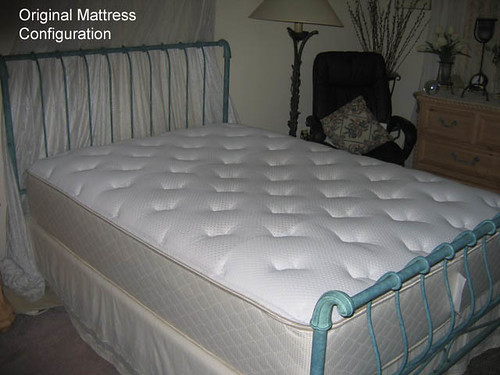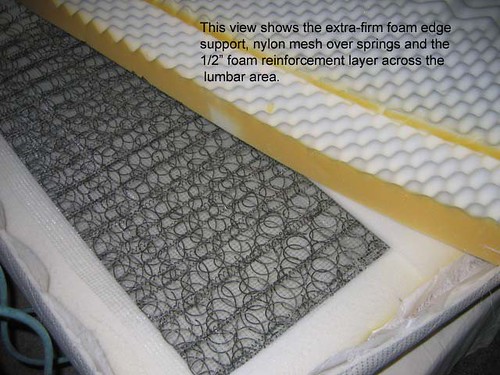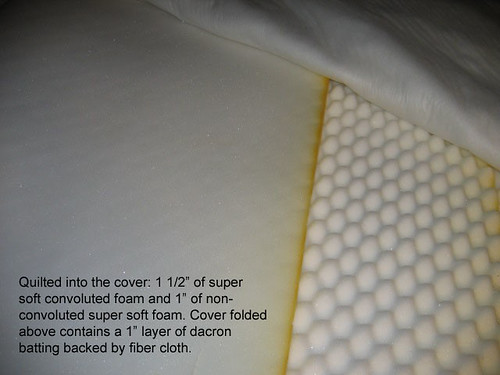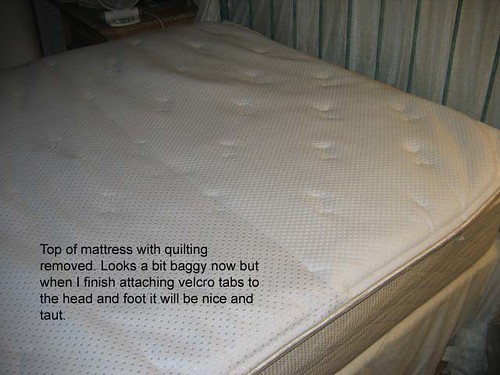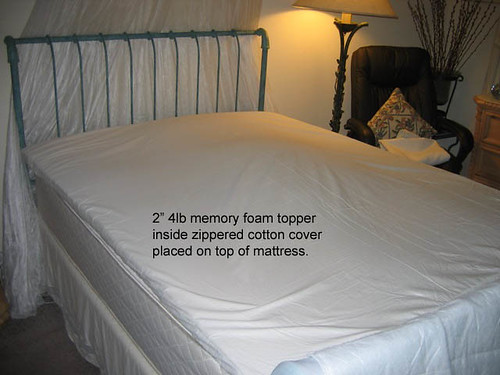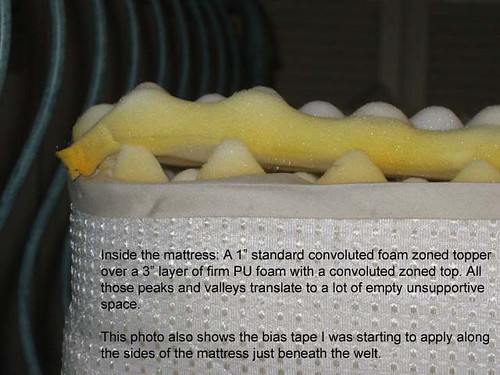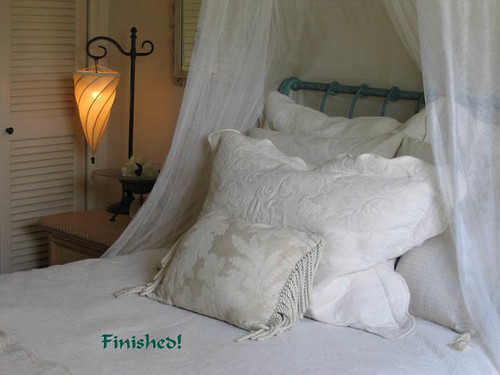The First CutOne morning last September I got out of bed and decided this was the day I was going to perform mattress surgery. I’d had my Spring Air Back Supporter Luxury Firm for fifteen months and it had started to go soft and unsupportive at nine—not that it was ever really all that comfortable to begin with. I’d had to bolster the lumbar area with a couple of pieces of remnant carpeting covered by a flat feather pillow and some half inch HR foam. I was tired of sleeping on a ridge. For months I’d been working up the nerve to cut open an expensive piece of bedding, and after waking up early yet again with lower back pain I made up my mind. It was time.
Thanks to Jimsocal and TheQuest I had seen a couple of mattress surgeries on the Forum and had a good idea of how to go about it and what to expect. Jim and TheQuest used a different approach than the one I decided on. Jim removed the welting and eventually the entire top of the mattress. TheQuest made her incision on the bottom and slipped off the top and sides like a box top. I wanted to retain the top and be able to open it like a suitcase—mattress kit style, since I thought that would afford me the best degree of functionality for moving things around inside. Using an X-acto knife I punched a small slit in the side of the mattress just under the welt. Then I cut around on three sides with a scissors. It was tough going since there were a lot of liners and batting to cut through but eventually I had a nice clean incision below the welt and was able to flip the top open like a big suitcase.
Under The HoodThe mattress surgeries I’d seen were both performed on Sealys from Costco, and I was expecting to find several thin layers of cheap PU foam and a fiber mat over the springs. But once I got under the hood I found that Spring Air makes them differently. Just beneath the cover was a 1” layer of zoned convoluted PU foam that looked no different from an eggcrate topper you could buy at any store. But under that was a single 3” piece of firm base foam with a convoluted top that rested over the springs and a 3” wide ledge of very firm edge foam that encased the spring unit.
That kind of threw me off my game since I’d intended to remove most, if not all of the PU foam and replace it with a 1” medium latex topper and a 2” 4lb memory foam topper over the fiber mat and the springs. Except… there wasn’t even a fiber mat. Just the two pieces of foam. Well… when the going gets tough the tough go to lunch—which is exactly what I did. And when I returned I decided to remove all the PU foam anyway and go ahead with my original plan.
I removed the PU and popped in the latex and MF, closed the cover and lay down. Whoa! Way too soft! So I swapped the 2” MF for the 1” version from Overstock.com. That was better. In fact it felt very nice. And even though there was only half the amount of foam inside the cover than there was before visually it was barely noticeable due to the amount of foam sewn into the cover. I attached three Velcro tabs to hold the cover in place, slipped my mattress pad over the top and made up the bed feeling very accomplished. The newly configured mattress felt so much more cushy and comfortable than the original—which had always seemed hard but not really firm—just sort of mushy and not supportive enough.
If It Sounds Too Good To Be True… I continued to enjoy the new surface for the rest of the day—reading and later on, watching TV. Unfortunately when I woke up the next morning I had a really bad backache. The kind of backache I hadn’t experienced since I returned a Talalay latex mattress to SleepEZ. I knew immediately the mattress was now too soft and not rigid enough to properly support my lower back. How confusing. Less foam. More pain! Not really what I was expecting.
Feeling a bit discouraged I put the carpet remnants back on. Under the foam this time rather than on top of the cover the way I’d had it originally. But with less foam beneath it all it seemed to do was make the mattress so hard on my hips it was painful and I just couldn’t sleep on it. When I started this I thought it was going to be an easy fix but now all I could think of was a line from an old Monty Python sketch—“This redistribution of the wealth is trickier than I thought.”
Unwilling to choose between a backache or bruised hips, in disgust I put everything back the way it had been. It seemed I had cut my mattress open and gone to a lot of trouble only to find I was no better off than before. This thing had me stumped. I had to think about it a bit.
And Now For Something Completely Different…At first I wondered if the spring unit itself had too much give to be properly supportive, but actually with the carpeting in place the mattress felt rigid enough. There was absolutely no sagging. More and more I began to suspect the problem resided in the soft, squashy foam sewn into the cover. Eventually I decided it would have to come out.
But that was a real project. The most difficult, time consuming, back breaking aspect of the entire process. I worked on removing the stitching from the quilting for weeks, a little at a time. My back wasn’t up to tackling the entire thing in one sitting—or rather one standing—along with a lot of bending and straining and leaning over while I worked on it with a seam ripper. Honestly. I don’t know whose brilliant idea it was to sew all that deep tufting into mattress tops in the first place. To me it feels like sleeping on a lumpy old mattress and I hated it from day one. Sticking a memory foam topper over it only made it marginally better.
Eventually I had taken out all the tufting except for a few stitches here and there that were sewn down too tight to remove without damaging the cover. All that remained was to cut out the foam. It was about two months before I got around to that.
Version 2.0When I started this project I thought it would be a piece of cake—take off the existing PU, replace with some latex and memory foam and voila—instant bliss. When that didn’t happen I became a little discouraged and lost my enthusiasm for the task. I needed to step away from it for awhile and rethink my strategy.
One evening I was reading the Forum and came across Chris137’s reference to a featherbed. That got me thinking. I’d been sleeping on a feather pillow for months now. In fact I’d been sleeping on a feather pillow on my old mattress for years. Wouldn’t a featherbed be just like a big pillow? Suddenly I really wanted to find out. My enthusiasm had resurfaced. And the timing couldn’t have been better because Kohl’s had a terrific price on just the one I wanted the day after Thanksgiving. But there didn’t seem to be any point to putting it on the bed until the soft squishy foam had been removed from the cover. So I was finally motivated to tackle that.
Using my trusty X-acto knife I make an incision on the underside of the cover just above the stitching that ran along the welting. When it was big enough the get my finger under I felt around to determine what I had to cut. The back of the cover was lined with fiber cloth. Underneath that were two layers of extremely soft PU foam. One flat 1” piece and an 1 ½” piece of the ubiquitous convoluted foam. I cut along the edge with a scissor. It was slow going cutting through 2 ½” of foam and a layer of fiber cloth and my hand was really sore by the time I finally finished. Surprisingly removing the remaining stitches of tufting that had been so hard to remove in the first place was the easiest part. They put up no resistance at all when I took a seam ripper to them. And finally the foam was out.
I had thought at that point I would have a thin, limp piece of knit material left as a cover, but I discovered it was still backed by yet another layer of fiber cloth with about an inch of batting behind it so the cover still had some body.
The whole thing took about 90 minutes and my back was really killing me from all the bending and straining. All I wanted to do was get the bed made up and lie down. But first I had to see what the mattress felt like with all that soft foam gone. Actually it felt quite firm. Hard in fact. I was elated. Now, I thought, we’re getting somewhere.
On went the featherbed and over it the 1” Overstock.com MF topper. With everything secure beneath a mattress pad I made up the bed and lay down. At first I was a little surprised to find myself sinking into the featherbed. My objective was to have a layer of firm, compressed material on the bed, but I knew from sleeping on a feather pillow that it would quickly mash down once the air was pressed out of it, so I rolled around the bed for a bit making sure it flattened out evenly. I guess I liked the feeling of it because I was so pooped from working on the mattress that I actually fell asleep for about a half hour just testing it out! Later that night when I got into bed I turned over on my side and went right to sleep.
I really thought this was it—at last. I had found the winning combination. I loved the way it felt and I loved being free to roll anywhere I wanted without the constraints of sleeping on a narrow section of mattress firmed up with carpeting. But I few days later I started waking up with lower back pain and I knew it was just too soft.
The carpeting went back on but it was difficult to locate under the 2” featherbed and a 1” MF topper, and it wasn’t giving my back enough rigidity. The discomfort in my lumbar area just seem to get worse every day until after two weeks I conceded that no matter how much I liked the way the mattress felt it was just too soft for me. I hated to return it, but the last thing I needed was yet another unused topper cluttering up my closet.
Without the extra soft foam in the cover the mattress was now so firm that I was able to put my 2” 4lb memory foam topper on. Now the bed felt cushy without feeling smooshy. I left the carpeting in place under the feather pillow because my back was bothering me, but without the extra cushioning underneath it was so hard that it hurt my hip and I was finding it difficult to fall asleep. After a couple of nights of that I widened the gap between the two sections so that my hip rested in the space between them but I still had the extra firm support along my ribcage and shoulder where I liked it.
I wasn’t sure if this was going to work either. I’d tried so many things and failed to find a comfortable solution each time, but once I spaced the carpet remnants I found that not only was my back feeling better each day, some mornings I was actually so comfortable and cozy I was reluctant to get out of bed! This arrangement felt pretty good—better than the mattress had ever felt before, but I still wasn’t completely satisfied. I really wanted to get the bed to the point where I could dispense with the carpeting entirely and still strike the right balance between support and comfort. I began to focus on the one remaining layer of convoluted foam between the cover and the 3” base layer of firm foam.
And The Winner Is… Back when all the regulars on the Forum were snapping up the 1” Natura latex toppers from Brylane I got one too even though I’m not a fan of Talalay and buying a latex mattress had been an unmitigated disaster. I still liked the idea of latex—in small quantities and combined with other materials. I always knew I would use it some day, although every time I had tried to use it on this particular mattress it had made the bed feel way too soft and unsupportive. Still, now that I had removed those 2 ½” of soft squishy convoluted foam from the quilting I was ready to try it one more time. So off came the 1” zoned convoluted PU eggcrate that came with the mattress and on went the Brylane topper over the 3” firm PU layer.
At first I wasn’t really sure I was going to like it because it did make the mattress noticeably softer, but unlike previous attempts it no longer seemed to interfere with the support, and it didn’t give me a backache. And because the latex was under the cover and isolated from my body by a layer of batting, 2” of memory foam and a mattress pad the jiggly Jello character of Talalay was completely canceled. All that was left was a really nice soft surface that cradled my body comfortably. At last I had achieved the coveted Ahhhh Factor. Admittedly things aren't perfect. I still have lower back issues. I had them before I got this mattress and I’ll have them long after it’s gone. Because of that I opted to keep the carpeting on one side of the bed because my back gets stiff while I sleep and rolling over onto a really firm rigid surface to work the kinks out beats rolling off the bed and lying on the floor—particularly on a cold winter morning. Hey, you do what you have to… But now I can get into bed at night, get comfortable and quickly fall asleep. I no longer find myself waking up early tossing and turning with a backache. In fact, some mornings I’m so comfy I don’t want to get out of bed at all. And that’s something I haven’t had the pleasure of feeling for a long time.
The winning configuration from the bottom up is: Open offset innerspring unit inside foam encasement 3” firm PU foam with zoned convoluted top (guestimate: 35-38 ILD) 1” Talalay latex (guestimate: 26-28 ILD) Mattress cover with 1” of batting 2” 4lb memory foam on top of mattress
Remarks On Spring Air Mattress Construction: I don’t know if this is true of all Spring Air mattresses, but once I’d cut mine open and looked inside I was rather impressed with the way it was put together. I’d seen a few dissected Sealys and the construction looked pretty crappy: Thin layers of raggedy looking foam, flimsy looking foam encasement. Even the spring unit looked cheap. I was expecting to find the same sort of thing inside this Back Supporter but the mattress actually looked as nice on the inside as it did on the outside. It was nicely finished with a lot of attention to detail in a place most people would never get to see.
On the other hand, Spring Air makes a lot of their “reinforced” center third which is supposed to provide better support where most of your body weight is. This leads you expect heavier gage coils in the lumbar region, but I found no evidence of this at all. The coils appear throughout. The “reinforcement” seems to be nothing more than the use of “zoned” convoluted foam, and even this is not true zoning, just a different arrangement of convolutions and an additional ½” piece of non-convoluted foam laid across the center of the mattress over the springs.
At Spring Air they just love their convoluted foam. This mattress has plenty of it. Just about every piece of foam is convoluted. My question is why? I can’t tell you how much better it feels since I replaced most of it. (Actually I just did.) Particularly the super soft convoluted foam quilted into the cover. All those peaks and valleys just squash down and provide no support and really no comfort whatsoever. And don’t even get me started on the current trend of puffy tufted mattress tops. What is the point of buying a new mattress if it’s going to feel like a lumpy old mattress? Just removing the tufting was an improvement in itself.
Finally, it’s a sad commentary on the state of today’s mattress industry when you have to cut open a mattress that’s not even two years old and replace just about everything inside of it because it has failed to provide comfort and support much beyond the one year mark. But that’s pretty much the rule these days rather than the exception. I slept on my last Spring Air mattress for 20 years. I couldn’t even go two years on this one.
Photos hosted by Flikr This message was modified Feb 6, 2009 by cloud9
|
| Cloud9, Thanks for sharing the pics of your new set up and explaining how you came about it yourself. I love your newly made up bed with the pillows. Please keep us updated on your comfort and if this new set-up is working for you to help others that still prefer a conventional mattress. |
|
Great post, Cloud9! Glad to see more and more people taking things into their own hands and becoming "Mattress Surgeons"! For those who want to see what she's talking about, the way the CostCo Sealy Fenways for example are made, check out this little slide show : (It wasn't working the other day but today it seems to be working. If you find it does not work, try it again another time.): http://img134.imageshack.us/slideshow/player.php?id=img134/1785/1201983161pn8.smil (copy and past the whole thing from the http to the .smil ) I can't believe you went to all that trouble to un-knit the top quilting! When I realized mine was perhaps part of my problem, I just cut the whole thing off and threw it away! My philosophy is that once you put a sheet or two over the whole mattress, no one sees it, anyway! Anyway, I hope it works out for you but if it doesn't, don't be afraid to try something completely new and different. I recently came to the conclusion that it was the damned Sealy SPRINGS that were bad, and so I threw mine out. Now I'm sleeping on the overnightmattress.com M-Grade foam core with 2" of memory foam (which I now have on the bottom so I'm just sleeping on the foam core but with a thick wool topper over it), and I am having the best sleep I've had in at least 2-3 years! I am loving it! The reason I mention it is because someone mentioned that your new build may be too soft. Well, when I first felt my new overnightmattress.com foam mattress I thought it was too soft. And I was right. That's when I put the memory foam on the bottom. But when I turned it over, it STILL felt too soft to the touch and I thought "Man! No way this is 42ILD (I don't think it is and now they seem to have changed their web site to reflect that it is indeed 32ILD), it's just too soft to sleep on! BUT, after 2 weeks or so of sleeping on the M-Grade core with the wool topper, I absolutely LOVE it! I guess the M foam must be just different enough from the HR foam I'd been using, to make a major difference and even though it is not said to do so, it does seem to conform to my body much like Memory Foam does, but with more support and SO FAR it has not gotten too soft. I have 90 days to try it so if it does get too soft I will get my money back and see about buying a firmer M-Grade foam somewhere. Didn't mean to hijack your thread, but just wanted to comment that "soft doesn't always mean bad" ; and that if you find you don't like your new bed, you may want to try foam without the springs. I hope it works for you the way it is! This message was modified Feb 8, 2009 by jimsocal
|
|
Hi Jim-- I was hoping you'd read my post since you were one of the mattress surgery pioneers who convinced me to just go for it. Yeah, I almost can't believe I went to the trouble of removing the tufting from the mattress either. It really was the most back-breaking, time-consuming part of this whole thing, but the more I experimented the more convinced I became that the really soft convoluted PU foam in the quilting was the major problem here. Plus I just hated the way the tufting felt. I know you just removed the entire top but I really wanted to keep the lid on so to speak, although you're absolutely right--a mattress pad holds everything in place and it really doesn't make a difference what's underneath it. So for anyone else attempting this, go ahead and just remove the top entirely if you don't want to spend hours removing the stitching and cutting out excess foam. On the springs... someone on the Forum mentioned that today's innerspring units are thinner gage steel than they used to be 20 years ago and that's got to mean less resistance and less support. I noticed that this mattress has more give to it than my old Spring Air that hardly has any give at all when I lie on it. So maybe your Sealy wasn't shot at all. It just didn't have enough support for you. I guess if I find the springs are becoming less and less supportive I can just remove them and use the case to hold something like Lux or that M-grade foam. Although down the line, I'd love to find someone who can make me a mattress to order like Beddy-Bye and Kait. Just a nice, super sturdy innerspring and cotton batting and just a hint of HR foam. I'm really thrilled you finally seem to have found a comfortable mattress, and now I'm very curious about this M-grade foam, because I know how uncomfortable you were on your old mattress even after you reconstructed it. Seems like the foam is both soft AND supportive like my old Dunlop latex mattress. Right now this mattress isn't too soft. If it was I'd remove either the latex or swap out the 2" MF for the 1" MF. The base foam underneath is pretty firm. Maybe not for a big guy, but for me, it's HARD. And hard isn't necessarily good either. At some point when I feel like experimenting again I may try taking off the base foam and just use the latex and MF over the springs. Last time I tried this it gave me a backache, but I still had the soft foam in the quilting, so it was like 5 1/2" of soft foam! Please keep us posted on how that Overnight Mattress continues to perform. You may be on to a new alternative to latex, MF and HR. |
|
Hi Lynn-- Glad you enjoyed the picture of the finished product. I think a bed should not only feel good--it should look good too. You probably feel the same way! |
|
I had dejavu looking at your pictures! Yes, there should be a layer or two of an insulator...burlap or a wire mesh. In my last bed(I retired it to the kids..they like it and sleep with all the foam inside). Another suggestion given to me by my bed-guy...put the carpet layer under the springs where you need it...it pushes them up and makes them more supportive. You could add it under the mattress itself instead. I thought it was hooey when I was told that but it did work. I wonder if your springs are part of the problem? Can you rotate them? I wonder if you can just buy a set of new springs somewhere...Leggett and Platt have a new offset coil out that looks intriguing. I think you are 100% correct about the mattress top foam. When I had the last go round with the last mattress, the mattress maker told me that was the problem. My Stress-O-Pedic mattress looked very similar to yours except it had individually wrapped coils which don't work for me. Good pictures...wish I'd thought of taking some. Kait |
|
That was an interesting suggestion from your mattress guy--Carpeting UNDER the springs. I have the carpeting on top of the mattress cover right now on one side of the bed for when I need something more firm (well, kind of hard actually) to lie on. At one point in my experimentations I moved the carpeting under all the foam layers on top of the springs, but that just seemed to feel hard without making the mattress more supportive. I wondered if placing something under the springs would make the springs feel stiffer, but I was reluctant to pull up the nylon mesh insulator that covers them. It's tacked down to the foam encasement and I was afraid I'd tear it if I tried to pull it off or that I wouldn't be able to properly secure it again. I'm not really sure how placing the carpeting under the mattress itself would make much of a difference since it already rests on a solid foundation. I know it works with a true box spring though. One of these days when I'm feeling adventureous I'll give it a try. Getting foam is easy. Getting a hold of an innerspring unit...not so much! |
| Isn't that the same as using a piece of plywood over the boxed foundation and under the mattress for some people to firm it up? |
|
He told me to put it under the mattress on top of the box spring. That's pretty easy. I've done it with foam to try to get more hip support. kait |
| If you have a true box spring placing something solid between it and the mattress really will make the bed feel firmer. On the other hand if you have a foundation which is already a solid surface, it won't make any difference. |

